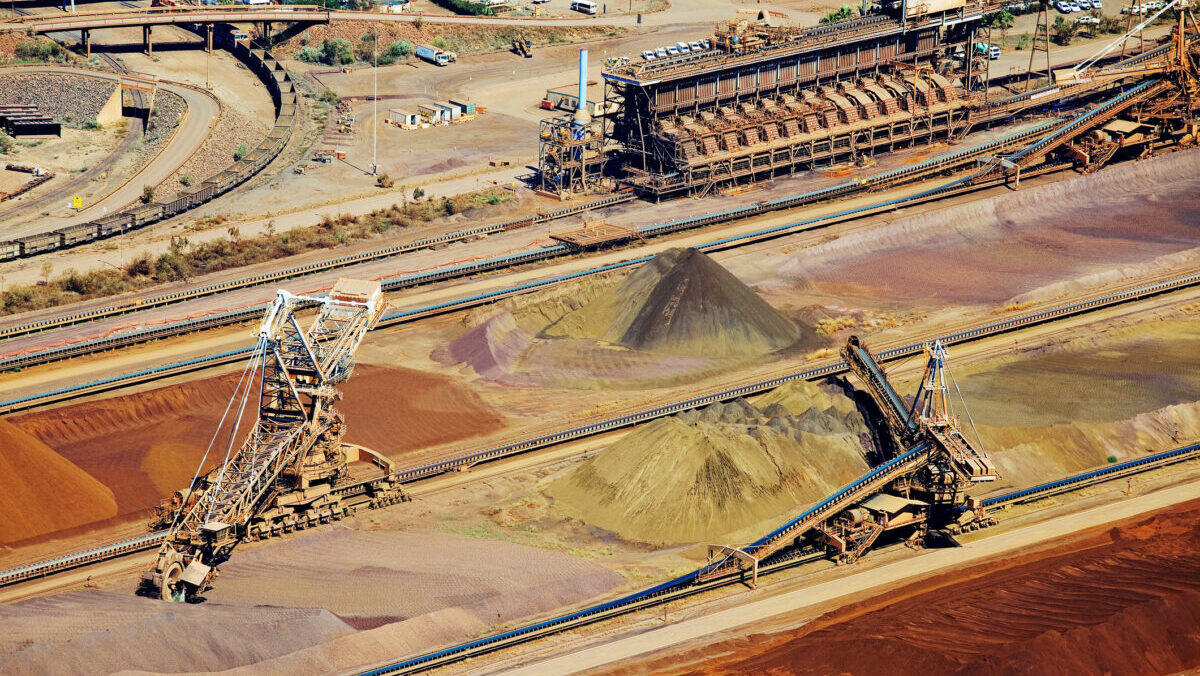Bulk Buys: BHP and Coronado look to India to keep bulk metals in sweet spot

Pic: John W. Banagan/Stone via Getty Images
- Iron ore prices shocked to the upside last year, with BHP saying ‘contestable demand’ has eluded bearish estimates for the past five years
- BHP CEO Mike Henry is bullish on India as a growing hub for steel production, but coking coal could do better out of the narrative than iron ore
- Iron ore prices fall hard on Tuesday despite Chinese rate cut
BHP’s top number cruncher Huw McKay has a warning for anyone predicting the era of the iron ore miner will be done and dusted as China moves to curb the steel output whose growth has made the world’s biggest miner so successful.
The Big Australian is targeting a ramp up in iron ore production over the coming years. After producing in the order of 142Mt in the Pilbara last half, placing it on track for full year guidance of 282-294Mt, the miner has its sights set on hitting a rate of 305Mt medium term, with studies on a ramp up to 330Mtpa due by FY25.
That may seem ill-advised in the knowledge other Pilbara miners like Rio Tinto (ASX:RIO), Fortescue (ASX:FMG), Mineral Resources (ASX:MIN) and Hancock are looking to do similar, while a massive new source of supply is expected to hit the market in the latter stages of the 2020s in the Simandou mine out of Guinea, West Africa.
At the same time China’s steel production levels have plateaued, recording slightly over 1Bt for the fifth year running, with expectations its demand will moderate as the years go by, scrap steel builds up, emissions restrictions become stricter and the Middle Kingdom revitalises domestic production to wean off imports.
But the latter hit a record high last year with the failure of Chinese authorities to impose environmental or commercial restrictions on steel mills losing an average of US$7 for every tonne produced emerging as a “Godot never came” moment for iron ore prices, McKay said.
“Contestable” iron ore demand was some 187Mt higher than it was five years ago, and while majors disappointed by 30Mt over the past five years, high cost producers have lifted output by 188Mt “essentially enough to constitute a new “major”,” McKay noted.
Even in the past two years contestable demand has risen 45Mt while majors have supplied only an extra 12Mt between them.
“It is useful to remember that just five years ago, in the midst of the US–China trade war, expectations for the iron ore industry were subdued,” McKay said.
“Half a decade ago, the consensus outlook for iron ore was that demand would be modest, low–cost seaborne supply from the major basins would increase, higher–cost supply would be progressively squeezed out, the cost curve would flatten, and prices would soften. In reality the opposite has happened on every score.”
How long can this continue?
The feeling around China is that without stimulus hopes converting to reality, iron ore prices will eventually soften.
Initial indications are the sort of “Bazooka” stimulus that took iron ore prices to US$230/t and above in May 2021 is not on the cards yet.
“The extent that policymakers support the Chinese economy looms as a major uncertainty for commodity markets. It’s easy to see why a large stimulus package, often referred to as ‘bazooka’ style stimulus, is increasingly being considered by the market given the speculated and enacted policy measures over the last six months,” Commbank’s Vivek Dhar said in a note yesterday.
“However, just in January, Chinese Premier Li Qiang noted at the World Economic Forum that China did “not seek short term growth while accumulating long term risk” last year. These comments suggest targeted and incremental policy support measures were prized in 2023.
“If these principles were enacted again this year, it would mean a broad‑based stimulus package that typically supports heavy infrastructure investment (25‑30% of China’s steel demand) will be unlikely.”
But China’s iron ore demand and steel production has been surprisingly robust without that lever. Realised prices rose 21% for BHP to more than US$103/wmt in the first half of FY24 — the US$9.7 billion EBITDA pull from BHP’s flagship iron ore assets offsetting a virtual collapse of its nickel business and hard times in its coal assets to support an unchanged US$6.6b underlying profit in yesterday’s half year accounts.
Market factors overlooked
McKay indicated the glum outlook for iron ore considered by BHP and others last year — based on very real concerns about the health of China’s property sector — overlooked important tailwinds in other economic data.
“What careful observers of the economy and the steelmaking value chain saw in calendar 2023 were (a) strength in a broad range of non–housing activities that are collectively very important for steel demand,” he said.
“(b) The fact that over the course of this multi-year downturn commercial housing had shrunk appreciably in terms of its total share of steel end–use, and therefore even with profound weakness in property, it was becoming a less influential swing factor in the overall balance.
“(c) A near–record overall run–rate for crude steel (measured in various ways) was sustained for most of the year, and BF mills gained share within that, allowing for extremely high utilisation rates (d).
“These high utilisation rates led to consistently strong port outflows of iron ore, (e) these outflows, and limited incremental supply from low–cost seaborne exporters, contributed to a steady trend decline in iron ore port stocks from 142 Mt in late February 2023 down to a new record low of 108 Mt after the Golden Week mill restocking in early October.
“After the usual seasonal lift in the final few months, the overall change in port stocks for the full calendar year was –12 Mt YoY, despite a record year for imports and +10 Mt YoY from Chinese domestic production, (f) the record year for imports was made possible by a +57 Mt increase in higher–cost and swing supply, which thickens the cost support membrane even further.”
But BHP has learnt to be realistic too. Indonesia’s battery nickel supply rush is a case in point, where BHP is now considering shutting down its long-running Nickel West operations because it does not see deficits returning until the 2030s.
They still think the cost curve will determine the long run price, with China turning to West Africa and domestic sources to reduce their reliance on Australia and Brazil.
Yet India could be BHP’s friend in both iron ore and coking coal.
Henry sees Indian demand on the rise
In fact India is now BHP’s largest customer in metallurgical coal.
It produced around 141Mt of crude steel in 2023, up 12% YoY, and is the only major source of growth in the global market. India plans to produce some 300Mt by 2030.
“I was there a number of number of months back now, but I came away so energised by the feeling on the ground, they’re both by way of the numbers that we’re seeing, as well as the mood amongst everyday Indian policymakers I met with and so on, it’s a country that’s on the move,” Henry said on a media call yesterday.
“And you certainly see that coming through in the demand for coking coal for example, with India being being our largest market, now for metallurgical coal, and they’re looking to double steel production by the end of this decade.
“And at the rate they’re going in the past few years they certainly seem to be moving in the right direction.”
But BHP is not banking on India to anchor the price of iron ore if China’s demand dissipates, with Henry noting it has its own sources of high quality domestic iron ore reserves.
“Medium to long term we see tonnes coming out of West Africa, more tonnes coming out of the Pilbara and so on. And we’ll see how that plays out over over time,” Henry said.
“The safest thing for us to do is ensure that we are at the very low end of the cost curve with the most cost competitive iron ore business in the world. And that’s we’ve managed to achieve in recent years.”
Iron ore prices in Singapore fell hard by 4.5% yesterday to a touch over US$121/t despite news of a surprise rate cut from the People’s Bank.
ASX iron ore stocks
Scroll or swipe to reveal table. Click headings to sort.
| CODE | COMPANY | PRICE | WEEK RETURN % | MONTH RETURN % | 6 MONTH RETURN % | YEAR RETURN % | MARKET CAP |
|---|---|---|---|---|---|---|---|
| ACS | Accent Resources NL | 0.01 | 0% | 25% | 25% | -60% | $ 4,731,272.83 |
| ADY | Admiralty Resources. | 0.007 | 0% | 17% | 0% | -36% | $ 9,125,054.07 |
| AKO | Akora Resources | 0.135 | 0% | -4% | -16% | -23% | $ 12,822,679.89 |
| BCK | Brockman Mining Ltd | 0.027 | 4% | 8% | -10% | 8% | $ 250,566,267.54 |
| BHP | BHP Group Limited | 45.54 | -1% | 0% | 4% | -5% | $ 233,364,779,793.48 |
| CIA | Champion Iron Ltd | 8.13 | 1% | 5% | 48% | 9% | $ 4,293,566,963.54 |
| CZR | CZR Resources Ltd | 0.31 | 11% | -7% | 94% | 51% | $ 64,827,027.65 |
| DRE | Dreadnought Resources Ltd | 0.019 | 0% | -30% | -59% | -79% | $ 69,631,459.20 |
| EFE | Eastern Resources | 0.008 | 0% | 0% | -27% | -53% | $ 9,935,571.69 |
| CUF | Cufe Ltd | 0.015 | -6% | -6% | -6% | -17% | $ 19,483,910.21 |
| FEX | Fenix Resources Ltd | 0.26 | 4% | -2% | -12% | 0% | $ 177,127,569.60 |
| FMG | Fortescue Ltd | 28.21 | -1% | 2% | 39% | 27% | $ 87,442,603,671.20 |
| RHK | Red Hawk Mining Ltd | 0.65 | -7% | 7% | -1% | 44% | $ 116,759,391.89 |
| GEN | Genmin | 0.160002 | 0% | 0% | 3% | 0% | $ 79,339,701.97 |
| GRR | Grange Resources. | 0.445 | 0% | 5% | -12% | -58% | $ 509,229,027.12 |
| GWR | GWR Group Ltd | 0.096 | 4% | 13% | 12% | 66% | $ 30,194,365.57 |
| HAV | Havilah Resources | 0.145 | -3% | -9% | -46% | -59% | $ 47,495,881.50 |
| HAW | Hawthorn Resources | 0.083 | 0% | -15% | -28% | -17% | $ 27,806,295.88 |
| HIO | Hawsons Iron Ltd | 0.038 | 6% | -16% | 3% | -51% | $ 34,005,629.18 |
| IRD | Iron Road Ltd | 0.056 | -7% | -14% | -40% | -47% | $ 47,700,545.25 |
| JNO | Juno | 0.076 | -5% | -28% | -4% | -22% | $ 14,191,730.28 |
| LCY | Legacy Iron Ore | 0.015 | -6% | 0% | -17% | 0% | $ 102,509,219.18 |
| MAG | Magmatic Resrce Ltd | 0.028 | -7% | -33% | -58% | -71% | $ 9,170,783.94 |
| MDX | Mindax Limited | 0.04 | 0% | -22% | -23% | -32% | $ 81,822,351.20 |
| MGT | Magnetite Mines | 0.26 | 0% | -4% | -34% | -66% | $ 26,085,149.13 |
| MGU | Magnum Mining & Exp | 0.023 | 35% | -12% | -39% | 5% | $ 17,805,950.87 |
| MGX | Mount Gibson Iron | 0.51 | 2% | -6% | 28% | -11% | $ 625,665,122.50 |
| MIN | Mineral Resources. | 59.41 | 5% | 2% | -6% | -30% | $ 11,730,704,322.80 |
| MIO | Macarthur Minerals | 0.14 | 4% | 0% | -26% | -10% | $ 24,938,023.20 |
| PFE | Panteraminerals | 0.053 | -2% | -4% | -37% | -54% | $ 8,222,598.04 |
| PLG | Pearlgullironlimited | 0.029 | 12% | -6% | 16% | -33% | $ 5,522,628.33 |
| RHI | Red Hill Minerals | 5.08 | -1% | 0% | 18% | 4% | $ 332,297,524.00 |
| RIO | Rio Tinto Limited | 128.04 | -1% | 0% | 21% | 3% | $ 48,614,475,385.44 |
| RLC | Reedy Lagoon Corp. | 0.005 | 0% | 0% | -29% | -43% | $ 3,097,703.66 |
| CTN | Catalina Resources | 0.004 | 0% | 33% | 0% | -56% | $ 4,953,947.57 |
| SRK | Strike Resources | 0.035 | 0% | -24% | -31% | -57% | $ 9,931,250.00 |
| SRN | Surefire Rescs NL | 0.011 | -8% | 10% | -31% | -21% | $ 21,594,735.94 |
| TI1 | Tombador Iron | 0.014 | 0% | 0% | -33% | -44% | $ 30,218,753.22 |
| TLM | Talisman Mining | 0.205 | 17% | -13% | 41% | 28% | $ 39,547,273.29 |
| VMS | Venture Minerals | 0.015 | 25% | 67% | 7% | -40% | $ 37,570,221.60 |
| EQN | Equinoxresources | 0.245 | -2% | -18% | 44% | 29% | $ 24,282,000.72 |
| AMD | Arrow Minerals | 0.005 | -17% | 0% | 100% | -17% | $ 17,368,825.48 |
Coronado also looks to India
BHP is not the only big player looking to India as a source of future demand.
Met coal miner Coronado (ASX:CRN) told shareholders yesterday global met coal demand would rise from 358Mt to 613Mt by 2050, driven heavily by a 3.5x rise in Indian steel output.
Around 24% of Coronado’s coal revenues are generate from exports to India, where GDP growth rates of 6.4% and 6.1% are forecast in the next two years.
It comes with tight supplies keeping premium hard coking coal prices strong, reported at upwards of US$310/t yesterday.
Coronado is aiming to boost output from its Curragh mine in Queensland by 2Mtpa to 13.5Mtpa by developing a new underground area which will enter production later this year.
That ramp up will dovetail with the retirement in 2026 and 2027 of legacy deals to supply 3Mt of coal a year to the Queensland Government’s Stanwell.
That will include the retirement of a rebate CRN has had to pay Stanwell which came to $137, in 2023, with the new supply arrangement to total 2Mtpa.
It means 1Mtpa previously sold at below market price to Stanwell as thermal coal will be made available to be sold as PCI in the international market. Combined, CRN expects its EBITDA will be boosted by US$290m a year.
Lower commodity prices, weather in Queensland, geotechnical problems at the Buchanan mine in the US and higher tax and royalty charges saw CRN’s profit slide over 79% to US$156.1m in 2023.
It produced 15.8Mt of saleable coal, a number it plans to lift to 20.5Mt by 2025.
ASX coal stocks
Scroll or swipe to reveal table. Click headings to sort.
| CODE | COMPANY | PRICE | WEEK RETURN % | MONTH RETURN % | 6 MONTH RETURN % | YEAR RETURN % | MARKET CAP |
|---|---|---|---|---|---|---|---|
| NAE | New Age Exploration | 0.004 | 0% | -20% | -20% | -43% | $ 7,175,595.64 |
| CKA | Cokal Ltd | 0.099 | -1% | -18% | -6% | -46% | $ 105,737,000.04 |
| BCB | Bowen Coal Limited | 0.061 | 3% | -26% | -54% | -78% | $ 167,796,324.38 |
| SVG | Savannah Goldfields | 0.03 | -14% | -21% | -60% | -84% | $ 7,916,473.36 |
| GRX | Greenx Metals Ltd | 1 | -6% | 10% | 7% | 38% | $ 273,189,227.00 |
| AKM | Aspire Mining Ltd | 0.185 | 0% | 0% | 89% | 208% | $ 88,836,472.38 |
| AVM | Advance Metals Ltd | 0.039 | 22% | 8% | -68% | -81% | $ 1,523,228.25 |
| YAL | Yancoal Aust Ltd | 5.81 | 2% | 5% | 14% | 4% | $ 7,539,709,185.27 |
| NHC | New Hope Corporation | 4.46 | -14% | -16% | -21% | -14% | $ 3,939,263,262.24 |
| TIG | Tigers Realm Coal | 0.005 | 0% | -9% | -29% | -58% | $ 78,400,214.21 |
| SMR | Stanmore Resources | 3.45 | -4% | -18% | 24% | -11% | $ 3,172,898,551.68 |
| WHC | Whitehaven Coal | 6.84 | -9% | -16% | -6% | -9% | $ 5,814,375,448.80 |
| BRL | Bathurst Res Ltd. | 0.9 | 1% | -3% | -11% | -5% | $ 170,310,204.20 |
| CRN | Coronado Global Res | 1.4 | -8% | -16% | -10% | -35% | $ 2,481,151,520.40 |
| JAL | Jameson Resources | 0.03 | 3% | -6% | -41% | -57% | $ 13,507,732.98 |
| TER | Terracom Ltd | 0.28 | 10% | -30% | -36% | -63% | $ 208,251,221.10 |
| ATU | Atrum Coal Ltd | 0.004526 | 0% | 0% | 0% | -17% | $ 11,966,853.96 |
| MCM | Mc Mining Ltd | 0.145 | -3% | 12% | -6% | -43% | $ 59,144,157.88 |
| DBI | Dalrymple Bay | 2.77 | 0% | 1% | 3% | 13% | $ 1,373,259,817.59 |
| AQC | Auspaccoal Ltd | 0.085 | -7% | -15% | -44% | -55% | $ 44,628,180.42 |
UNLOCK INSIGHTS
Discover the untold stories of emerging ASX stocks.
Daily news and expert analysis, it's free to subscribe.
By proceeding, you confirm you understand that we handle personal information in accordance with our Privacy Policy.








